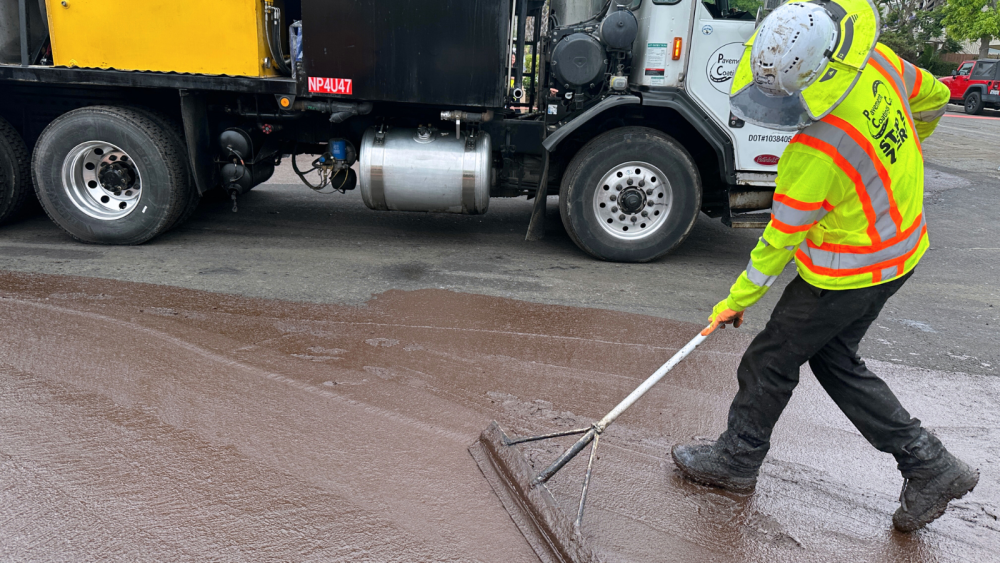City of San Diego Marks Completion of 500 Miles of Road Resurfacing in One Year

Marking another successful effort to repair and resurface streets citywide, Mayor Todd Gloria joined City Councilmember Stephen Whitburn and City staff today at the location of a slurry seal project at Locust Street in Loma Portal, to celebrate the completion of approximately 500 miles of street paving and repair during fiscal year 2025 (FY25), which ended June 30.
These 500 miles of paving performed in fiscal year (FY25) are almost 8% of San Diego’s total road network and include more than 340 miles of slurry seal resurfacing, more than 140 lane miles of asphalt overlay paving and 24 miles of mill and pave treatment from the City’s in-house paving teams. Combined, this makes FY25 one of the most productive years for road resurfacing this decade, underscoring the City’s commitment to infrastructure investments.
“Fixing San Diego’s streets has been a top priority of mine since day one—and even in the face of serious budget challenges, we’re getting it done,” said Mayor Todd Gloria. “Resurfacing 500 lane miles in a single year shows what’s possible when we focus on delivering results for our residents. We’re building safer, smoother streets in every part of San Diego, and we’re not letting up.”
Notably, the FY25 investment in road repair has contributed to an overall improvement of the City’s pavement condition, with a 2-point increase in the Pavement Condition Index (PCI) score since the 2023 pavement condition assessment.
Funding for road repair in fiscal year 2026 (FY26) is projected to be $83.1 million, which will yield over 350 miles of pavement repair and resurfacing. While the reduced funding for FY26 doesn’t build on the number of miles that will be able to be paved, the Transportation Department predicts that the work done in FY26 will preserve the current PCI of 65 achieved by the last two years of dedicated and effective resurfacing work by the Department’s paving program.
Historically, the City of San Diego reported the number of miles repaired and resurfaced using “repair miles.” As part of the 2023 pavement condition assessment, data were collected to allow the Transportation Department to report improved and targeted mileage in “lane miles”, a more accurate and industry-standard measure. While repair miles were calculated as the total length of the street, if a street was less than 50 feet wide, lane miles are calculated as the total length of individual lanes within a street. Currently and moving forward, the Transportation Department will use lane miles instead of repair miles when reporting mileage improvements and target.
“Completing this many paving miles is a year-long process requiring hard work and careful planning from City staff and our resurfacing partners,” said Transportation Director Bethany Bezak. “We appreciate the support from all of our San Diego communities and look forward to fixing and maintaining our streets in the new fiscal year.”
The City treats roads using three different methods: surface seal, asphalt overlay, and reconstruction. City engineers plan and design surface seal and asphalt overlay projects, applied to streets in good to poor condition, and City-hired contractors complete these projects. Transportation Department crews perform asphalt overlay and reconstruction on streets in poor to failed condition.
Slurry seal is a cost-effective pavement preservation method that extends the life of streets already in good condition by 5 to 8 years. Slurry seal is used to prevent the deterioration of streets, which is vital to improving the overall condition of San Diego’s 6,600-mile road network. It reduces the need for a more costly asphalt overlay and reconstruction for badly deteriorated streets.
Asphalt overlay, a more intensive type of road repair used on streets in fair to poor condition, requires a larger investment, but can last up to 25 years.
The Transportation Department also operates three in-house mill and pave teams that rehabilitate roads to protect the structural integrity of damaged streets, but typically in shorter sections than the asphalt overlay process.
Streets are selected for repair and resurfacing through a pavement management system that helps determine both the timing and most appropriate type of repair. Based on the pavement's roughness and cracks, each street segment is assigned a PCI score.
To prioritize street paving, the PCI is evaluated in conjunction with other factors, such as traffic volume, road type, equity, mobility, maintenance history, other planned construction projects, and available funding. Repairs are often grouped within a neighborhood to include streets in similar condition or performed after other street-disturbing projects, such as pipeline replacement.
Find out more information on the City of San Diego’s Paving Program by viewing the Transportation Department’s Pavement Management Plan.
View a map of past, current and future street repair in your neighborhood by visiting the City’s interactive StreetsSD map.
